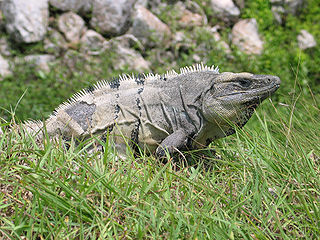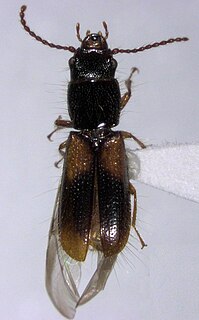Related Research Articles

Populus section Aigeiros is a section of three species in the genus Populus, the poplars. Like some other species in the genus Populus, they are commonly known as cottonwoods. The species are native to North America, Europe, and western Asia. In the past, as many as six species were recognized, but recent trends have been to accept just three species, treating the others as subspecies of P. deltoides.

Ctenosaura is a lizard genus commonly known as spinytail iguanas or ctenosaurs. The genus is part of the large lizard family, Iguanidae and is native to Mexico and Central America. The name is derived from two Greek words: ctenos (κτενός), meaning "comb", and saura (σαύρα), meaning "lizard".
Leptosiaphos is a genus of skinks endemic to West Africa.
In biology, a monotypic taxon is a taxonomic group (taxon) that contains only one immediately subordinate taxon. A monotypic species is one that does not include subspecies or smaller, infraspecific taxa. In the case of genera, the term "unispecific" or "monospecific" is sometimes preferred. In botanical nomenclature, a monotypic genus is a genus in the special case where a genus and a single species are simultaneously described. In contrast an oligotypic taxon contains more than one but only a very few subordinate taxa.

Sabal is a genus of palms endemic to the New World. Currently, there are 17 recognized species of Sabal, including one hybrid species. The species are native to the subtropical and tropical regions of the Americas, from the Gulf Coast/South Atlantic states in the Southeastern United States, south through the Caribbean, Mexico, and Central America to Colombia and Venezuela. Members of this genus are typically identified by the leaves which originate from a bare, unarmed petiole in a fan-like structure. All members of this genus have a costa that extends into the leaf blade. This midrib can vary in length; and it is due to this variation that leaf blades of certain species of Sabal are strongly curved or strongly costapalmate or weakly curved, weakly costapalmate,. Like many other palms, the fruit of Sabal are drupe, that typically change from green to black when mature.

Scops owls are typical owls in family Strigidae belonging to the genus Otus and are restricted to the Old World. Otus is the largest genus of owls with 58 species. Scops owls are colored in various brownish hues, sometimes with a lighter underside and/or face, which helps to camouflage them against the bark of trees. Some are polymorphic, occurring in a greyish- and a reddish-brown morph. They are small and agile, with both sexes being compact in size and shape. Female scops owls are usually larger than males.
The Karthala scops owl, also known as the Grand Comoro scops owl or Comoro scops owl, is a small, scops owl endemic to the island of Grande Comore in the Comoro Islands.
Gastón Guzmán Huerta, a Mexican mycologist and anthropologist, was an authority on the genus Psilocybe.

Grandidier's trident bat is a species of bat in the family Hipposideridae endemic to Madagascar. It was formerly assigned to the genus Triaenops, but is now placed in the separate genus Paratriaenops.

Paratriaenops furculus, also known as Trouessart's trident bat, is a species of bat in the family Hipposideridae. It is endemic to Madagascar. It was formerly assigned to the genus Triaenops, but is now placed in the separate genus Paratriaenops. A related species, Paratriaenops pauliani, occurs in the Seychelles.

Typhleotris is a genus of cavefish that are endemic to caves in southwestern Madagascar. Although traditionally considered to belong to the family Eleotridae, studies show that they represent a distinct and far-separated lineage together with the Milyeringa cavefish from Australia, leading some to move them to their own family, Milyeringidae.

Roupala is a Neotropical genus of woody shrubs and trees in the plant family Proteaceae. Its 34 species are generally found in forests from sea level to 4000 m altitude from Mexico to Argentina.

Chaetosomatidae is a small family of beetles, in the suborder Polyphaga.

Oryzomys albiventer is a rodent in the genus Oryzomys of family Cricetidae from interior western Mexico, in the states of Jalisco, Guanajuato, and Michoacán. First described in 1901 as a separate species, it was later lumped under O. couesi and the marsh rice rat (O. palustris) until it was reinstated as a species in 2009. It differs from neighboring Oryzomys populations in size and measurements and is a large, brightly colored species with a long tail and robust skull and molars. Its range has been much impacted by agricultural development, but isolated populations are thought to persist.

Palleon nasus, commonly known as the elongate leaf chameleon, is a species of chameleon endemic to Madagascar. It was initially described by Boulenger in 1887. The species contains two subspecies, P. n. nasus and P. n. pauliani. It grows no more than 9 cm.

Palleon is a genus of small chameleons erected in 2013 for a small clade formerly assigned to the genus Brookesia. The species of Palleon are endemic to Madagascar.

Paratriaenops is a genus in the bat family Hipposideridae. It is classified in the tribe Triaenopini, along with the closely related genus Triaenops and perhaps the poorly known Cloeotis. The species of Paratriaenops were placed in Triaenops until 2009. Paratriaenops currently contains the following species:

Paratriaenops pauliani is a species of bat in the family Hipposideridae. It is endemic to Aldabra Atoll of the western Seychelles, where it was found on Picard Island. It was formerly considered to be part of the species Triaenops furculus, known from Madagascar, and was initially assigned as a new species within the genus Triaenops. Later it as well as T. furculus were placed in the separate genus Paratriaenops. A related species, Paratriaenops auritus, also of Madagascar, was similarly reassigned.
Malgassochaetus pauliani is a species of beetles in the family Chaetosomatidae. It is found in Madagascar.
Schizomus is a genus of hubbardiid short-tailed whipscorpions, first described by Orator Cook in 1899.